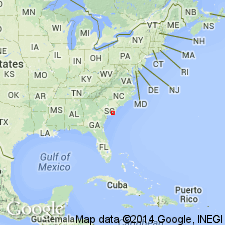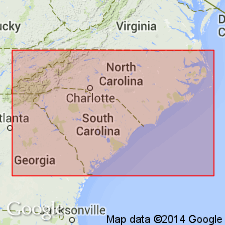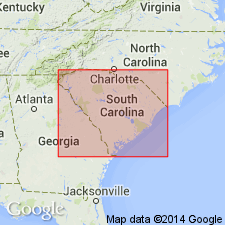
- Usage in publication:
-
- Goose Creek Limestone*
- Modifications:
-
- Named
- Dominant lithology:
-
- Limestone
- AAPG geologic province:
-
- Atlantic Coast basin
Summary:
The Goose Creek phase of Sloan (1908) in the Charleston, SC, area, is here revived, formalized, and named the Goose Creek Limestone. It consists of gray to white, medium- to coarse-grained, quartzose, phosphatic, sparsely shelly calcarenite. Unconformably overlies the Ashley Member of the Cooper Formation. Thickness at type section is 3 m. Age is early to middle Pliocene.
Source: GNU records (USGS DDS-6; Reston GNULEX).

- Usage in publication:
-
- Goose Creek Limestone
- Modifications:
-
- Revised
- AAPG geologic province:
-
- Atlantic Coast basin
Summary:
Several new Goose Creek localities have yielded calcitic shells and latex molds of approximately 250 species (Campbell, in prep). It appears that the Goose Creek Limestone near Charleston and in Horry Co. contains distinct lower and upper faunal zones. The Berkeley and Horry Co. faunas differ in their affinity with upper Miocene to lower Pliocene versus mid-Pliocene (Duplin and Raysor Marl) molluscan faunas. Their beds may be separated by an unconformity. The Berkeley beds represent a lower faunal zone, and the Mason Dixon beds (at the now flooded Mason Dixon Co. pit) represent an upper faunal zone. Lower and upper Goose Creek faunal zones are lithologically inseparable and so there is no justification at present for formally subdividing the unit into lower and upper members. All Conway area and Horry Co. Goose Creek Limestone outcrops, including the stratotype of the "Bear Bluff Formation," can now be correlated with the upper Goose Creek Limestone faunal zone. The Berkeley Quarry beds, the Goose Creek Limestone stratotype, and the Givhans Ferry section all correlate with the lower Goose Creek faunal zone. (The Givhans Ferry section is the informal stratotype of the "Givhans Beds" of McCartan (1991) as well as the neostratotype (rejected in this paper) of the Raysor Formation.) Age of the Goose Creek is middle Pliocene. It is the author's opinion that the Goose Creek and the Bear Bluff Formation are the same unit based on faunal and lithologic similarities and he recommends the abandonment of the Bear Bluff.
Source: GNU records (USGS DDS-6; Reston GNULEX).

- Usage in publication:
-
- Goose Creek Limestone
- Modifications:
-
- Areal extent
- Biostratigraphic dating
- AAPG geologic province:
-
- Atlantic Coast basin
Summary:
Precise age and areal extent of the Goose Creek Limestone have been difficult to determine because of limited outcrops and sparse and disparate fossil assemblages. The Goose Creek is found in northeastern GA at Porter's Landing, in eastern SC, and in southeastern NC. Unit is divisible biostratigraphically into informal lower and upper units. The Raysor Marl unconformably overlies the lower Goose Creek Limestone, a reversal of the inferred stratigraphic sequence presented in other reports. The upper Goose Creek and the Raysor appear to be laterally equivalent, coeval lithofacies and both are older than the Duplin Formation. The Goose Creek unconformably overlies the Wabasso beds. The Bear Bluff is lithically and faunally the same as the Goose Creek. Authors present a thorough documentation of the Goose Creek Limestone fauna, which provides the evidence for present correlation and age assignments. An early mid-Pliocene age for the Goose Creek is supported by molluscan range zones. Unit is shown in figure 1 as ranging from approximately 3.9 Ma to 3.4 Ma. This agrees with the planktic foraminiferal zone PL-3 assignment of Ward and Huddlestun (1988) and the nannoplankton zone NN15 to mid-NN14 of Bybell (1990).
Source: GNU records (USGS DDS-6; Reston GNULEX).
For more information, please contact Nancy Stamm, Geologic Names Committee Secretary.
Asterisk (*) indicates published by U.S. Geological Survey authors.
"No current usage" (†) implies that a name has been abandoned or has fallen into disuse. Former usage and, if known, replacement name given in parentheses ( ).
Slash (/) indicates name conflicts with nomenclatural guidelines (CSN, 1933; ACSN, 1961, 1970; NACSN, 1983, 2005, 2021). May be explained within brackets ([ ]).

